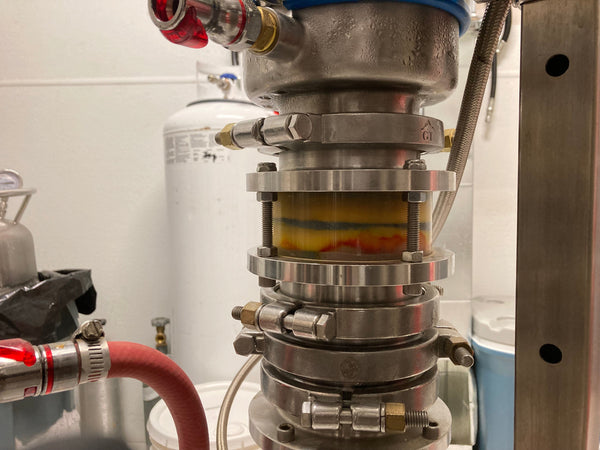What is Chromatography? How Does it Play a Role in the Extraction Process?
Feb 11, 2025
When you think about the science behind cannabis products, chromatography might not be the first thing that comes to mind. Yet, this sophisticated separation technique is essential in maintaining the quality, purity, and potency of everything from oils to edibles.
Chromatography is so much more than just a technical process—it allows for the creation of purer and more effective cannabis products. But what exactly is it, and how did it enter the cannabis industry?
What is Chromatography?
Chromatography is a highly specialized separation technique for analyzing and purifying complex mixtures. It is an essential component of modern extraction and testing processes.

At its core, chromatography involves the interaction between two phases: the mobile phase, which is typically a liquid or gas, and the stationary phase, a solid or liquid medium. As the mobile phase carries the mixture through the stationary phase, individual compounds interact with the stationary material differently based on their chemical properties, leading to their separation.
Adsorption is the primary mechanism in this process. In this mechanism, molecules adhere temporarily to the surface of the stationary phase. This mechanism differs from absorption, in which molecules penetrate the material's body.
Each compound’s distinct adsorption behavior, influenced by polarity and molecular structure, determines how long it remains in the stationary phase before being carried forward by the mobile phase. The delay, known as retention time, serves an essential function in isolating distinct components within cannabis.
Terms like elution, which describes extracting a compound as it exits the stationary phase, and polarity, which affects molecular interactions, are fundamental in understanding how chromatography works.
These principles are indispensable for cannabinoid-based extracts, allowing precise separation of cannabinoids, terpenes, and impurities. Chromatography verifies the purity and potency of cannabis products to support compliance efforts and ensure the quality of consumer-ready products.
Chromatography’s Role in Cannabis Extraction
Chromatography made its way into the cannabis industry as companies sought reliable methods to purify extracts and maintain compliance with increasingly stringent regulatory standards.

In its early days, chromatography was primarily used for analytical testing, helping labs verify potency and screen for contaminants like pesticides, heavy metals, and residual solvents. As the demand for cleaner, more refined products grew, so did the role of chromatography in the cannabis sector.
Initially, the process was employed to refine crude oil extracts by separating and removing unwanted compounds while preserving cannabinoids and terpenes. However, strict adherence to the federal THC cap of 0.3% required an exceptional accuracy method for hemp-derived products, making this process indispensable.
Today, chromatography has a dual role in the cannabis industry. In analytical testing, it is indispensable for determining cannabinoid concentrations, terpene profiles, and contaminants. In purification, it isolates specific cannabinoids, allowing processors to produce targeted formulations like THC-free CBD oils or products enriched with minor cannabinoids.
Techniques like reversed-phase chromatography are employed to separate cannabinoids with similar polarities, such as THC and CBD, that traditional methods struggle to distinguish.
Chromatographic Techniques Used in Cannabis Extraction
The cannabis industry relies on a range of chromatographic methods, each offering unique advantages for both extraction and analytical testing.

These techniques allow for precisely separating, identifying, and purifying cannabinoids, terpenes, and other compounds, ensuring that products meet regulatory standards and consumer expectations.
Centrifugal Partition Chromatography (CPC)
CPC uses a liquid-liquid system, with a liquid held in place by centrifugal force as the stationary phase. This design eliminates the need for solid particles, reducing clogs and extending operational efficiency.
CPC’s fast flow rates and minimal solvent usage make it cost-effective and environmentally friendly. Its flexibility allows it to serve dual purposes, as it excels in analytical testing and purification processes.
Flash Chromatography
Flash chromatography employs pressurized gas to move the mobile phase through a solid stationary phase, allowing for the rapid separation of compounds.
This technique is beneficial for removing pesticides and other impurities and isolating cannabinoids like THC and CBD. Its ability to handle high-throughput purification tasks makes it popular for large-scale processing.
Reversed-Phase Chromatography
Reversed-phase chromatography takes flash methods a step further by using hydrocarbon-coated silica to reverse the polarities of the stationary and mobile phases.
The process enables efficient separation of hydrophilic compounds such as THC and CBD, which traditional methods often struggle to differentiate. It’s ideal for producing high-purity extracts in applications requiring the separation of closely related cannabinoids.
High-Performance Liquid Chromatography (HPLC)
HPLC is the industry standard for analytical testing, offering unmatched precision in quantifying cannabinoids and other compounds. Its ability to operate without heat avoids decarboxylation of acidic cannabinoids like THCA, preserving their original profiles.
While HPLC systems can be costly and involve longer run times, their accuracy justifies the investment.
Gas Chromatography (GC)
GC is a powerful tool for profiling volatile compounds such as terpenes. It is often paired with flame ionization (FID) or mass spectrometry (MS) detectors. However, its reliance on heat can cause decarboxylation, making it much less suitable for analyzing raw acidic cannabinoids.
Supercritical Fluid Chromatography (SFC)
SFC uses CO2 in its supercritical state as the mobile phase, combining liquid and gas-like properties to achieve high separation efficiency.
This method is known for its eco-friendly properties. It uses recyclable CO2 and produces no harmful chemical residues, making it a preferred choice for purification.
Analytical Chromatography in the Cannabis Industry
Chromatography plays an essential role in analytical testing, which allows cannabis businesses to meet strict regulatory requirements while maintaining the purity and quality of their products.

Specific techniques, such as HPLC, GC, and SFC, are widely used to analyze cannabinoids, terpene profiles, and contaminants such as pesticides, heavy metals, and residual solvents. Each method offers distinct advantages based on the analyzed compounds and the product's intended use.
Among these, HPLC has become the gold standard for cannabinoid profiling. Its precision stems from its ability to separate and quantify compounds without relying on heat, avoiding decarboxylation that could alter the original chemical profile of acidic cannabinoids like THCA or CBDA.
Often paired with FID or MS, GC is another essential tool for identifying volatile compounds like terpenes. However, its reliance on heat makes it less suitable for analyzing raw acidic cannabinoids. Conversely, SFC provides a sustainable, solvent-efficient option, leveraging supercritical CO2 to achieve more detailed profiling.
Regulatory bodies mandate stringent testing thresholds for cannabis products. Pesticide residue limits and heavy metal cutoffs vary by state but are non-negotiable for market access.
Chromatography ensures these contaminants fall below allowable levels, producing results presented in Certificates of Analysis (COAs) and guaranteeing transparency, purity, quality, and compliance in cannabis products. Analytical chromatography, therefore, is much more than just a testing method; it is instead the foundation of trust and reliability in the cannabis industry.
Using Purification Chromatography to Isolate and Refine Cannabinoids
In the cannabis industry, purification chromatography is a critical step in transforming crude extracts into high-quality, targeted products for end users to enjoy.
The process isolates desired cannabinoids, such as CBD or THC, while removing impurities like waxes, lipids, and pesticides. The core of this separation lies in the unique adsorption rates of each compound as they pass through a stationary phase, often silica-based media, under the influence of a liquid mobile phase.
As crude oil moves through the stationary media, compounds interact with the surface differently based on their molecular properties. With this variance in "stickiness," compounds travel at different speeds, allowing for even more precise separation than other methods. It will enable processors to isolate minor cannabinoids like CBG or CBN, which are increasingly in demand for specialized product formulations.
Advanced techniques make the purification process even more efficient. Reversed-phase chromatography, for example, uses hydrocarbon-coated silica to switch the polarities of the mobile and stationary phases, separating closely related cannabinoids like THC and CBD.
Elevate Your Extraction Process with Confidence
Chromatography has cemented its role as a fundamental process within the cannabis industry, driving advancements in analytical testing and purification. Its ability to isolate cannabinoids, refine extracts, and maintain compliance with stringent regulations makes it indispensable for processors seeking to produce high-quality, clean-label products.

As consumer expectations grow and the demand for precision-engineered products increases, investing in reliable filtration solutions is more critical than ever. Media Bros. has you covered if you can improve your existing extraction process. Our expert team is here to help you select the perfect filtration media for your specific needs, projects, and operations.
To learn more about our products and how we can support your goals, contact us today at sales@mediabros.store or call us at 1-(503)-308-7138. Let us help you achieve superior results in every step of your extraction process.






